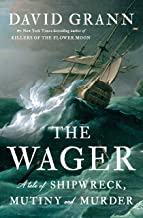 David Grann starts The Wager with a brief but extensive presentation of what an English wooden sailing vessel in the 18th century was like, and the perils common to those who went to sea in them. He then introduces three of the key players on the crew of His Majesty’s Ship the Wager, a man of war battleship, who survived to tell of their adventure.
David Grann starts The Wager with a brief but extensive presentation of what an English wooden sailing vessel in the 18th century was like, and the perils common to those who went to sea in them. He then introduces three of the key players on the crew of His Majesty’s Ship the Wager, a man of war battleship, who survived to tell of their adventure.
Survived what adventures? Therein lies the stories told so remarkably well by Grann.
The Wager sets sail in September 1740, as part of a convoy whose purpose was to capture a Spanish galleon headed west from Mexico to the Philippines carrying silver, part of the War of Jenkin’s Ear. The ships must go around Cape Horn or through the Strait of Magellan, some of the roughest and trickiest water in the world.
Then, on the Chilean (west) coast of Patagonia, the Wager loses sight of the convoy and wrecks on some rocky shoals and is a total loss. The crew find themselves stranded on a rocky island bereft of food or water except for the near-constant deluge falling from the skies.

They salvage as much food, ordnance, and other supplies as they can from the wreck of the Wager, build tents to shelter themselves from the terrible weather, and try to make a life for themselves while hoping for rescue. During the next several months adversary groups form, a group of indigenous people come by, but not much food is found, leaving the men to survive on seaweed.
Eventually, a plan is hatched to modify one of the bigger auxiliary boats from the Wager and use it to head south into the strait of Magellan and on to Brazil and, hopefully back to England. Not all groups agreed with the plan, making for, shall we say, an uncomfortable situation.
How it was resolved is the basis of the rest of the story, or three stories to be perfectly accurate. In it a small number of each group survives, and there is a court martial to determine blame for the loss of the Wager.
The book reads like a novel, as Grann ensures you can’t stop turning pages. The Wager is a beautifully written, well researched piece of British naval history.
As usual, it is a pleasure to encounter your thoughts in print.